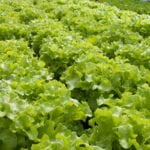Pressure treated wood is a popular choice for outdoor projects, but is pressure treated wood ok for vegetable gardens? When it comes to building raised beds and structures for your vegetable garden, the type of wood you choose can have a significant impact on the health and safety of your plants. In this article, we will dive into the topic of using pressure treated wood in vegetable gardens and explore the potential risks and benefits of this material.
Choosing the right type of wood for your vegetable garden is crucial for creating a healthy and thriving environment for your plants. While pressure treated wood offers durability and resistance to rot, it also raises concerns about the chemicals used in its treatment process leaching into the soil. In this section, we will discuss what pressure treated wood is, its purpose, and why it has become a popular yet controversial choice for building vegetable garden beds.
As we delve deeper into the pros and cons of using pressure treated wood in vegetable gardens, it’s essential to consider both sides of the issue. Understanding the advantages and disadvantages of this material will help gardeners make informed decisions about whether or not to use pressure treated wood in their vegetable gardens. Additionally, we will explore alternative options such as cedar, redwood, or composite materials that provide durability without the potential risks associated with pressure treated wood.
What Is Pressure Treated Wood
Pressure treated wood is a type of lumber that has been chemically treated to resist rot, decay, and insect damage. This process involves placing the wood in a pressurized chamber and forcing a preservative solution into the fibers of the wood.
The most common chemicals used in pressure treated wood are alkaline copper quaternary (ACQ) and copper azole (CA). These chemicals help protect the wood from fungal decay and termite damage, making it a durable and long-lasting material for outdoor construction projects.
The treatment process involves several steps. First, the wood is loaded into a treatment cylinder, where it undergoes a vacuum to remove air from the wood cells. Then, the preservative solution is added under pressure, forcing it deep into the wood fibers. Once the treatment is complete, any excess solution is removed, and the wood is dried to prevent warping or cracking.
The purpose of pressure treating wood is to extend its lifespan and improve its performance in outdoor environments. This makes pressure treated wood an attractive option for building raised beds or structures in vegetable gardens, as it can withstand exposure to moisture and soil for an extended period of time. However, there are important considerations regarding its use in vegetable gardens due to potential chemical leaching and impact on plant health.
| Pressure Treated Wood | Vegetable Gardens |
|---|---|
| Durable and long-lasting material for outdoor construction projects | Potential risks of chemical leaching into the soil and impacting plant health |
| Resists rot, decay, and insect damage | Alternatives such as cedar, redwood, or composite materials |
| Treated with preservatives like ACQ and CA | Safe practices for minimizing risk of chemical exposure to soil and plants |
Pros and Cons of Pressure Treated Wood
Pressure treated wood is a popular choice for constructing raised beds and other structures in vegetable gardens due to its durability and resistance to decay. The treatment process involves using chemicals to protect the wood from rot, insects, and other forms of deterioration. This makes pressure treated wood an attractive option for those looking for long-lasting materials for their garden projects. In addition, pressure treated wood is often more budget-friendly than alternative options such as cedar or redwood.
However, despite its benefits, there are potential drawbacks to using pressure treated wood in vegetable gardens. One of the main concerns is the leaching of chemicals into the soil over time. The chemicals used in the treatment process, such as chromated copper arsenate (CCA), have been found to be harmful to humans and the environment. As a result, there is a risk that these chemicals can leach into the soil and potentially contaminate the vegetables grown in the garden.
Another disadvantage is the potential harm to plant health that may result from exposure to chemical preservatives in pressure treated wood. While some studies suggest that certain chemicals used in pressure treated wood may not pose a significant risk to plant growth, there is still uncertainty about the long-term effects on vegetable crops. This uncertainty has led many gardeners to seek out alternative options that are considered safer for use in gardens where edible plants will be grown.
Potential Risks to Vegetable Gardens
When considering using pressure treated wood in your vegetable garden, it is important to be aware of the potential risks this type of wood may pose to your plants and soil. While pressure treated wood is known for its durability and resistance to decay, it also comes with the risk of chemical leaching into the surrounding environment.
The following are potential risks associated with using pressure treated wood in vegetable gardens:
- Chemical Leaching: The chemicals used to treat pressure treated wood, such as chromated copper arsenate (CCA), have been linked to leaching into the soil over time. This poses a potential risk of chemical exposure for both the plants and anyone consuming the vegetables grown in that soil.
- Harm to Plant Health: The leaching of chemicals from pressure treated wood can also harm plant health. Certain plants may be more sensitive to these chemicals, leading to stunted growth, discoloration, or even death.
- Soil Contamination: Over time, the chemicals from pressure treated wood can build up in the soil, leading to contamination. This can affect not only the current crop of vegetables but also impact future plantings in the same soil.
To mitigate these potential risks when using pressure treated wood in vegetable gardens, it is crucial to consider alternative materials or safe practices for minimizing chemical exposure. It’s essential for gardeners to weigh these potential risks carefully before deciding on using pressure treated wood for their vegetable garden projects.
Alternatives to Pressure Treated Wood
When building raised beds and structures in vegetable gardens, it is important to consider the type of wood or material used. While pressure treated wood is commonly used for its durability, there are potential risks associated with its use in vegetable gardens. As an alternative, there are several options available that can provide a safe and effective means of constructing raised beds and structures.
Alternative Options for Building Raised Beds and Structures:
- Cedar: Cedar is a popular choice for building raised beds due to its natural resistance to rot, insect damage, and decay. It also has a pleasant aroma and attractive appearance.
- Redwood: Redwood is another excellent option for building raised beds in vegetable gardens. It is naturally resistant to decay, which makes it a long-lasting choice for outdoor use.
- Composite Materials: Composite materials are an increasingly popular choice for building raised beds. These materials are typically made from a blend of recycled plastic and wood fibers, offering durability and low maintenance.
Using any of these alternative options provides numerous benefits without the potential risks associated with pressure treated wood. Not only do these alternatives offer longevity, but they also contribute to the overall aesthetics of the garden.
In addition to these alternatives, other options such as untreated pine or hemlock can also be considered for constructing raised beds in vegetable gardens. By choosing the right type of material, gardeners can ensure the safety and health of their plants while fostering a thriving vegetable garden environment.
Safe Practices for Using Pressure Treated Wood
When deciding to use pressure treated wood in a vegetable garden, it is important to take all necessary precautions to ensure the safety of the plants and soil. While pressure treated wood can be durable and long-lasting, it carries the risk of chemical leaching into the surrounding environment. To minimize this risk, there are several safe practices and tips that should be followed when using pressure treated wood in a vegetable garden.
Choose the Right Type of Pressure Treated Wood
Not all pressure treated wood is created equal. It is crucial to select wood that has been treated with safer chemicals, such as Alkaline Copper Quaternary (ACQ) or Copper Azole (CA), which are approved for use in vegetable gardens by the Environmental Protection Agency (EPA). These types of pressure treated wood are less likely to leach harmful chemicals into the soil and pose less risk to plant health.
Use a Barrier Between the Wood and Soil
One effective way to minimize chemical exposure is to place a barrier between the pressure treated wood and the soil. A heavy-duty plastic liner or thick landscape fabric can create a protective layer that prevents direct contact between the wood and the soil. This can help reduce leaching of chemicals into the garden bed.
Avoid Contact With Edible Plant Parts
If pressure treated wood must be used for raised beds or other structures within a vegetable garden, it is important to avoid allowing any edible plant parts, such as leaves or roots, from coming into direct contact with the wood. This can help prevent any potential uptake of chemicals by the plants.
By following these safe practices and tips, gardeners can mitigate some of the risks associated with using pressure treated wood in vegetable gardens. However, it’s important to consider alternative materials that may pose lower risks if concerns persist about potential chemical exposure from pressure treated wood.
Considerations for Long-Term Use
When considering the long-term use of pressure treated wood in vegetable gardens, it is important to understand the potential effects on the soil and plants, as well as the overall health of the garden. While pressure treated wood offers durability and resistance to decay, there are concerns regarding the leaching of chemicals into the soil over time. Understanding these considerations can help gardeners make informed decisions about using pressure treated wood in their vegetable gardens.
Impact on Soil and Plants
Over time, pressure treated wood has the potential to release harmful chemicals such as arsenic, copper, and chromium into the surrounding soil. These chemicals can be absorbed by plant roots and, in turn, affect their growth and overall health. Additionally, certain types of vegetables may be more susceptible to chemical uptake from pressure treated wood, leading to potential health risks for those consuming the produce.
To mitigate these risks, it is essential for gardeners to monitor the quality of their soil and regularly test for any chemical leaching from pressure treated wood. Consider planting less sensitive crops in raised beds made from pressure treated wood or using a protective barrier between the wood and soil to minimize direct contact with potentially harmful substances.
Overall Health of the Vegetable Garden
In addition to its impact on soil and plants, long-term use of pressure treated wood can have a broader effect on the health of the entire vegetable garden. Chemical leaching can alter the pH levels of the soil, which in turn affects nutrient availability for plants. This imbalance can result in stunted growth or nutrient deficiencies within the garden over time.
Gardeners should carefully consider whether they are willing to take on this risk when choosing materials for structures within their vegetable gardens. If opting for pressure treated wood, implementing safe practices such as using a polyethylene barrier or sealant can help minimize chemical exposure to both soil and plants. However, taking steps to prevent potential harm from occurring is critical when using pressure treated wood in vegetable gardens over an extended period.
Conclusion
In conclusion, the question “is pressure treated wood ok for vegetable gardens” is a complex one with no one-size-fits-all answer. It is important to carefully weigh the pros and cons of using pressure treated wood in vegetable gardens before making a decision.
While pressure treated wood is known for its durability and resistance to rot and insects, it also poses potential risks to the health of the soil and plants due to chemical leaching. As such, alternative options such as cedar, redwood, or composite materials may be preferable for building raised beds and structures in vegetable gardens.
For those who still choose to use pressure treated wood in their vegetable gardens, there are safe practices that can help minimize the risk of chemical exposure. This includes lining the inside of the bed with a plastic barrier to prevent direct contact between the wood and soil, as well as avoiding using pressure treated wood for growing edible plants directly. These precautions can help reduce the potential harm to plant health from chemical leaching.
Ultimately, the long-term effects of pressure treated wood on soil and plant health are still not fully understood. Therefore, gardeners should consider their options carefully and prioritize safety when choosing materials for their vegetable gardens. Whether using pressure treated wood or alternative materials, practicing good soil management and regularly monitoring plant health is essential for maintaining a thriving vegetable garden.
Frequently Asked Questions
Is It OK to Use Pressure Treated Wood in a Vegetable Garden?
Using pressure treated wood in a vegetable garden has been a topic of debate. While older pressure treated wood contained arsenic, newer formulations use safer chemicals like alkaline copper quaternary (ACQ). It is generally considered safe for vegetable gardens, but some gardeners prefer untreated wood to be extra cautious.
Is Home Depot Pressure Treated Wood Safe for Gardens?
Home Depot’s pressure treated wood is typically treated with ACQ, which is considered safe for use in gardens. However, it’s always best to verify the specific treatment used on the wood you’re purchasing and make an informed decision based on your comfort level with using treated wood in your garden.
What Type of Wood Is Best for Raised Vegetable Gardens?
The best type of wood for raised vegetable gardens is cedar. Cedar is naturally resistant to rot and insect damage, making it a durable choice for outdoor gardening. Additionally, cedar contains natural oils that act as preservatives, eliminating the need for chemical treatments often found in other types of wood.

If you’re looking to get into vegetable gardening, or are just looking for some tips on how to make your current garden better, then you’ve come to the right place! My name is Ethel and I have been gardening for years. In this blog, I’m going to share with you some of my best tips on how to create a successful vegetable garden.





